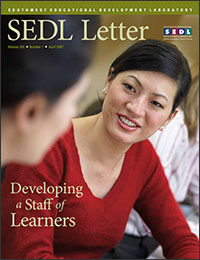After Hours: Professional Development for Afterschool Staff
 When the bell rings at the end of the school day, you can almost feel the tension evaporating as students grab their books and run out the door. Their minds turn from social studies to social events. More and more, however, these students are entering afterschool programs, where their teachers face the difficult task of letting the students relax while still encouraging their learning. Increasingly, educators and policymakers expect the hours after school to have a positive impact on student performance, forcing afterschool practitioners to become savvy in their attempts to meet these demands.
When the bell rings at the end of the school day, you can almost feel the tension evaporating as students grab their books and run out the door. Their minds turn from social studies to social events. More and more, however, these students are entering afterschool programs, where their teachers face the difficult task of letting the students relax while still encouraging their learning. Increasingly, educators and policymakers expect the hours after school to have a positive impact on student performance, forcing afterschool practitioners to become savvy in their attempts to meet these demands.
NCLB Fosters New Perspective
The role of afterschool programs has grown in importance since Congress authorized the creation of the 21st Century Community Learning Centers (CCLCs) program in 1994. When the No Child Left Behind Act (NCLB) was passed 7 years later, the 21st CCLC program's focus was narrowed to helping students, especially those in low-performing schools, meet academic standards. In addition to the hundreds of afterschool programs that were established as a result of the legislation, NCLB created a new demand for professional development that would teach afterschool professionals how to offer academic enrichment that was different from the school day but would still improve student achievement.
 The National Partnership for Quality Afterschool Learning at SEDL came together in 2003 in response to this new need. Funded by the U.S. Department of Education through the 21st CCLC program, the National Partnership identifies promising practices in high-quality afterschool education through firsthand observations of programs across the United States. The National Partnership also provides training and technical assistance to help other afterschool programs reach the same level of quality.
The National Partnership for Quality Afterschool Learning at SEDL came together in 2003 in response to this new need. Funded by the U.S. Department of Education through the 21st CCLC program, the National Partnership identifies promising practices in high-quality afterschool education through firsthand observations of programs across the United States. The National Partnership also provides training and technical assistance to help other afterschool programs reach the same level of quality.
During the site visits, the National Partnership researchers discovered that adequate staff development was not available to help afterschool professionals achieve what was expected of their program. For one thing, practitioners did not know how to meet the expectation that they would include academic enrichment in their programs.
"We noticed that most of the staff development that was available addressed programming needs but little else. These resources taught afterschool staff how to get funding and administer their program, but quality instruction wasn't part of the training," says Catherine Jordan, director of the National Partnership.
Other staff development issues included the range of experience and skills among afterschool instructors and the limited time and money available for training. Joe Parker, a SEDL program associate who coordinates the site visits for the National Partnership, says, "It is not uncommon to see a staff that includes certified teachers with years of teaching experience, college students, senior citizen volunteers who may or may not have taught, and employees from a community organization who are there to focus on the arts or some other elective but don't have much experience with academic instruction."
These issues create logistical challenges for providing staff development. Of course there are always conferences, but at many sites, only a program director and a site coordinator are able to attend due to financial constraints. Although they often return from the conference brimming with ideas and enthusiasm, they are unsure how to implement what they learned. Few programs have the funds to bring a trainer on-site. Time limitations also pose a challenge, as few afterschool programs offer paid in-service days set aside for staff development the way schools do.
The National Partnership staff realized they needed to develop training materials that program directors and site coordinators could use to conduct their own staff development sessions. These materials needed to be flexible enough for program directors to provide training on-site in a time increment that fit their schedule. They also needed to be affordable, preferably free.
Toolkit Offers Flexible, Focused Professional Development
 In response to this need, the National Partnership developed the Afterschool Training Toolkit, a free online resource for afterschool practitioners. The toolkit is organized by six content areas—literacy, math, science, the arts, technology, and homework help—with the different member organizations of the National Partnership developing the content according to their expertise. The Northwest Regional Educational Laboratory developed the literacy content; Mid-continent Research for Education and Learning developed the math content; the SERVE Center at the University of North Carolina at Greensboro developed the science and homework content; and SEDL developed the arts and technology content. While creating the prototype, the National Partnership conducted focus groups at the 21st Century Community Learning Center summer institute and incorporated the feedback into the toolkit. Currently, toolkits for literacy, math, science, and the arts are currently available. The toolkits for technology and homework help will be available in Spring 2007. All of the content is available online at no cost at www.sedl.org/ afterschool/toolkits/.
In response to this need, the National Partnership developed the Afterschool Training Toolkit, a free online resource for afterschool practitioners. The toolkit is organized by six content areas—literacy, math, science, the arts, technology, and homework help—with the different member organizations of the National Partnership developing the content according to their expertise. The Northwest Regional Educational Laboratory developed the literacy content; Mid-continent Research for Education and Learning developed the math content; the SERVE Center at the University of North Carolina at Greensboro developed the science and homework content; and SEDL developed the arts and technology content. While creating the prototype, the National Partnership conducted focus groups at the 21st Century Community Learning Center summer institute and incorporated the feedback into the toolkit. Currently, toolkits for literacy, math, science, and the arts are currently available. The toolkits for technology and homework help will be available in Spring 2007. All of the content is available online at no cost at www.sedl.org/ afterschool/toolkits/.
 Each content area of the toolkit contains such information as the subject's unique role in afterschool, research, and links and references for additional resources. Another important component of each content area is the promising practices—techniques that the National Partnership identified, through research and site visits, as effective in improving student achievement. For example, promising practices in science include investigating science through inquiry and exploring science through projects and problems.
Each content area of the toolkit contains such information as the subject's unique role in afterschool, research, and links and references for additional resources. Another important component of each content area is the promising practices—techniques that the National Partnership identified, through research and site visits, as effective in improving student achievement. For example, promising practices in science include investigating science through inquiry and exploring science through projects and problems.
The toolkit uses a theory-to-practice model, meaning it is based on research but shows people how to implement the practice. If, for example, an afterschool instructor reviews the promising practice called "Finding Math" in the math component of the toolkit, he or she can read research on the practice and how to use it in afterschool. Most training materials would stop there, but the toolkit also includes videos that show high-quality afterschool instruction in progress, providing the afterschool instructor the benefit of a classroom observation while sitting at the computer. For example, after reading about how to bring math to life through everyday activities, the instructor can watch a video of fifth- and sixth-grade students playing drums in a percussion group. In the video, a music teacher explains how he has infused a jam session with math enrichment. The students, who are clearly having fun, discuss what they have learned about fractions in their percussion class.
The toolkit also provides lessons to help afterschool instructors master the practice. It is important to keep in mind, however, that the toolkit is not a curriculum but a way for instructors to embed academic enrichment in their programs. The intent is that if an instructor watches the video and then teaches the lesson and reflects on it, that person will not just have found an activity to fill Wednesday afternoon but will have learned something about being a more effective educator.
Toolkit Training Available
The National Partnership offers training sessions to help leaders of afterschool programs use the toolkit for staff development. After they have become familiar with the toolkit, these leaders will return to their sites and serve as facilitators in staff development sessions.
The staff development sessions might be as short as 15 minutes and proceed as follows: first, the facilitator asks staff to read two paragraphs from the toolkit describing the promising practice called "Read Aloud." The facilitator may ask staff to think about the way they conduct Read Aloud with their students and then share their processes with the group. Next, the facilitator draws staff members' attention to the toolkit's video featuring a real-world afterschool program implementing a Read Aloud. The facilitator invites staff to take brief notes of the behaviors or processes that resonate with them. Following the video, the facilitator asks staff to share their thoughts and reflections through questions related to their practice (i.e., What processes/behaviors did you see that you already do regularly with your class? What aspects of the video did you like? What aspects would you like more information about? Would you try Read Aloud with your class? What additional information/materials might you need to try Read Aloud?).
 Christina McAnally, program director of an afterschool program in Hearne, Texas, attended a toolkit training session held by the National Partnership last October and has held staff development sessions based on the training. McAnally's staff consists primarily of college students. Although many of these instructors are education majors, they do not have the same experience that certified teachers do. McAnally has used the toolkit to improve the quality of instruction that her staff provides. She introduced the toolkit during their daily 30-minute staff meetings. Her staff then watched and discussed a video and selected a lesson that they would teach. After teaching the lesson, the staff reconvened at another meeting to discuss their experiences.
Christina McAnally, program director of an afterschool program in Hearne, Texas, attended a toolkit training session held by the National Partnership last October and has held staff development sessions based on the training. McAnally's staff consists primarily of college students. Although many of these instructors are education majors, they do not have the same experience that certified teachers do. McAnally has used the toolkit to improve the quality of instruction that her staff provides. She introduced the toolkit during their daily 30-minute staff meetings. Her staff then watched and discussed a video and selected a lesson that they would teach. After teaching the lesson, the staff reconvened at another meeting to discuss their experiences.
McAnally believes the toolkit has helped her staff provide higher quality instruction. "Before, we were weak in incorporating enrichment and academics [in our lessons]," she says. She refers to the Read Aloud practice in the literacy toolkit as an example. Before using the toolkit, her staff simply read stories. "After watching the Read Aloud video, they started asking pre- and post-questions when they read stories. There's always some sort of an enrichment activity after, like drawing a picture of the story," she says. Although the focus of the toolkit is mostly academic, McAnally has used the toolkit to model classroom management strategies that her staff may not have learned yet. Between better instruction and better classroom management, McAnally says, "We began to see students more engaged and fewer behavior problems."
Outcomes
The toolkit is helping afterschool professionals change the way they approach staff development. They are learning that, with the proper research-based tools, they can lead staff development sessions themselves. Those who achieve success with the toolkit can then serve as facilitators or coaches during the next professional development opportunity, and in this way, the leadership and learning are shared.
 "When we first began visiting afterschool programs, they thought professional development meant sending staff to a conference or paying hundreds, if not thousands, of dollars to fly someone in to lead a training session," says Joe Parker. "The toolkit is changing that."
"When we first began visiting afterschool programs, they thought professional development meant sending staff to a conference or paying hundreds, if not thousands, of dollars to fly someone in to lead a training session," says Joe Parker. "The toolkit is changing that."
The National Partnership continues to gather feedback on other ways the toolkit has affected and benefited afterschool programs. Like Christina McAnally, many practitioners have used the toolkit to help staff learn how to infuse academic content into their activities. These changes should enable project directors and site coordinators to develop action plans for moving forward in implementing academic enrichment as the focus of their program. As a result, instructors will come to better understand academic enrichment and plan accordingly. Sustaining their afterschool programs should become easier once site coordinators and project directors share student achievement data with school and community leaders showing that afterschool makes a difference. And although they might never use the toolkit themselves, boys and girls will benefit from engaging, academically enriched activities each day.


Portions of this article previously appeared in "Developing Professionally: Using the Afterschool Training Toolkit to Coach Your Staff to Success" in The AfterSchool Review (Fall 2006, pp. 27–30).
Next Article: Bricoleurs, Behaviors, and Beliefs

